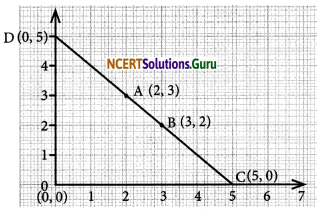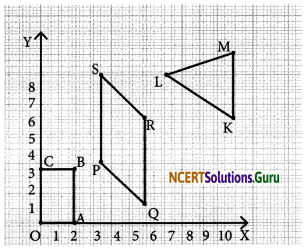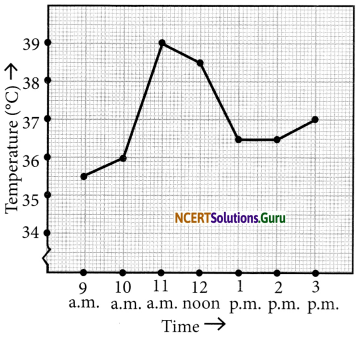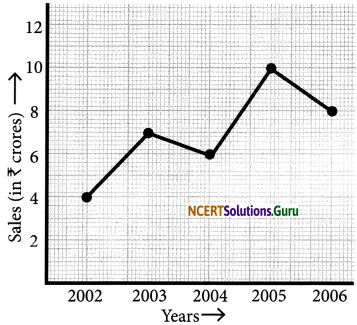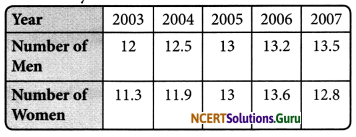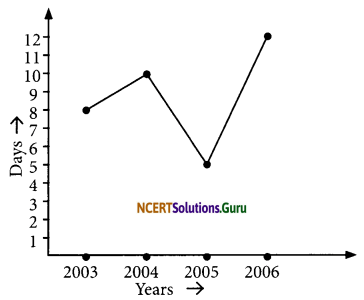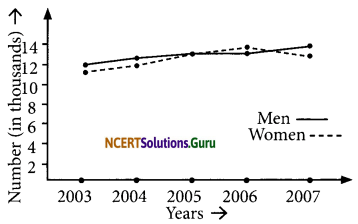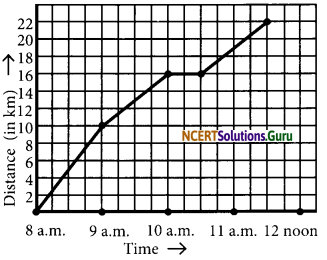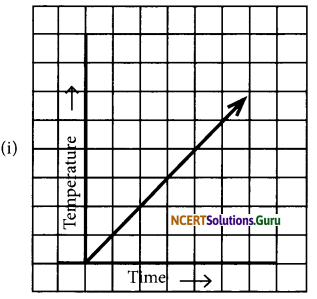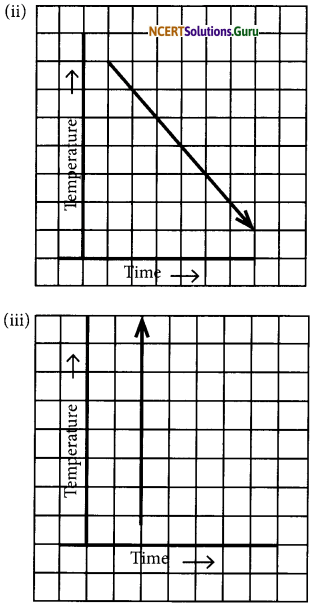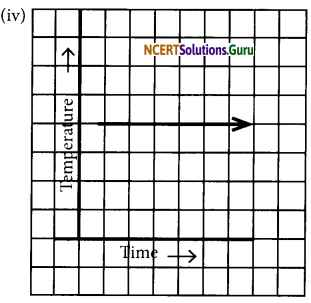These NCERT Solutions for Class 8 Maths Chapter 9 Algebraic Expressions and Identities Ex 9.5 Questions and Answers are prepared by our highly skilled subject experts.
NCERT Solutions for Class 8 Maths Chapter 9 Algebraic Expressions and Identities Exercise 9.5
Question 1.
Use a suitable identity to get each of the following products.
(i) (x + 3) (x + 3)
(ii) (2y + 5) (2y + 5)
(iii) (2a – 7) (2a – 7)
(iv) (3a – \(\frac{1}{2}\))(3a – \(\frac{1}{2}\))
(v) (1.1m – 0.4) (1.1m + 0.4)
(vi) (a2 + b2) (-a2 + b2)
(vii) (6x – 7) (6x + 7)
(viii) (-a + c) (-a + c)
(ix) \(\left(\frac{x}{2}+\frac{3 y}{4}\right)\left(\frac{x}{2}+\frac{3 y}{5}\right)\)
(x) (7a – 9b) (7a – 9b)
Answer:
(i) (x + 3) (x + 3) = (x + 3)2
= x2 + 2 × x × 3 + 32
= x2 + 6x +9
[Using the identity (a + b)2 = a2+ 2ab + b2]
(ii) (2y + 5) (2y + 5) = (2y + 5)2
= (2y)2 + 2 × 2y × 5 + 52
= 4y2 + 20y + 25
[Using the identity (a + b)2 = a2 + 2ab + b2 ]
(iii) (2a – 7) (2a – 7) = (2a – 7)2
= (2a)2 – 2 × 2a × 7 + (7)2
[using the identity (a – b)2 = a2 -2ab + b2]
= 4a2 – 28a + 49
(iv) (3a – \(\frac { 1 }{ 2 }\)) (3a – \(\frac { 1 }{ 2 }\)) = (3a – \(\frac { 1 }{ 2 }\))2
= (3a)2 – 2 × 3a × \(\frac { 1 }{ 2 }\) + \(\frac { 1 }{ 2 }\)2
= 9a2 – 3a + \(\frac { 1 }{ 4 }\)
[using the identity (a – b)2 = a2 – 2ab + b2]
(v) (1.1m – 0.4) (1.1m + 0.4)
= (1.1m)2 – (0.4)2 = 1.21m2 – 0.16
[using the identity (a × b)(a – b) = (a2 – b2)]
(vi) (a2 + b2) (-a2 + b2)
= (b2 + a2) (b2 – a2) = (b2)2 – (a2)2
= b4 – a4
[using identity (a + b) (a – b) = a2 – b2 ]
(vii) (6x – 7) (6x + 7)
= (6x)2 – 72 = 36x2 – 49
[using the identity (a + b)(a – b) = a2 – b2]
(viii) (- a + c) (- a + c) = (-a + c)2
= (-a)2 -2 × a × c + c2 = a2 – 2ac + c2
[Using identity (a – b)2 = a2 – 2ab + b2]

(x) (7a – 9b) (7a – 9b) = (7a – 9b)2
= (7a)2 – 2 × 7a × 9b × (-9b)2
[using identity (a – b)2 = a2 – 2ab + b2]
= 49a2 – 126ab + 81b2

Question 2.
Use the identity (x + a) (x + b) = x2 (a + b) x + ab to find the following products.
(i) (x + 3) (x + 7)
(ii) (4x + 5) (4x + 1)
(iii) (4x – 5) (4x – 1)
(iv) (4x + 5) (4x – 1)
(v) (2x + 5y) (2x + 3y)
(vi) (2a2 + 9) (2a2 + 5)
(vii) (xyz – 4) (xyz – 2)
Answer:
(i) (x + 3)(x + 7)
= x2 + (3 + 7) x + 3 × 7 = x2 + 10x + 21
(ii) (4x + 5)(4x + 1)
= (4x)2 + (5 + 1) 4x + 5 × 1
= 16x2 + 6 × 4x + 5
= 16x2 + 24x + 5
(iii) (4x – 5) (4x – 1)
= (4x)2 + (-5 -1) 4x + (-5) (-1)
= 16x2 + (-6) 4x + 5
= 16x2 – 24x + 5
(iv) (4x + 5) (4x – 1)
= (4x)2 + (5 – 1) 4x + 5 x (-1)
= 16x2 + (4) 4x – 5
= 16x2 + 16x – 5
(v) (2x + 5y) (2x + 3y)
= (2x)2 + (5y + 3y) 2x + 5y × 3y
= 4x2 + (8y) 2x + 15y2
= 4x2 + 16xy + 15y2
(vi) (2a2 + 9) (2a2 + 5)
= (2a2)2 + (9 + 5) 2a2 + 9 × 5
= 4a4 + (14) 2a2 + 45
= 4a4 + 28a2 + 45
(vii) (xyz – 4) (xyz – 2)
= (xyz)2 + (-4 -2) xyz + (-4) (-2)
= x2y2z2 + (- 6) xyz + 8
= x2y2z2 – 6xyz + 8

Question 3.
Find the following squares by using the identities.
(i) (b – 7)2
(ii) (xy + 3z)2
(iii) (6x2 – 5y)2
(iv)(\(\frac { 2 }{ 3 }\)m + \(\frac { 3 }{ 2 }\)n)2
(v) (0.4p – 0.5q)2
(vi) (2xy + 5y)2
Answer:
(i) (b – 7)2 = b2 – 2 b 7 + (-7)2
= b2 – 14b + 49
[Using the identity (a – b)2 = a2 – 2ab + b2 ]
(ii) (xy + 3z)2 = (xy)2 + 2 (xy) 3z + (3z)2
= x2y2 + 6xyz + 9z2
[using the identity (a x b)2 = a2 + 2ab + b2 ]
(iii) (6x2 – 5y)2
= (6x2)2 – 2 × 6x2 × 5y + (5y)2
= 36x2 – 60x2y + 25y2
[Using the identity (a – b)2 = a2 – 2ab + b2
(iv) ( \(\frac { 2 }{ 3 }\)m + \(\frac { 3 }{ 2 }\)n)2

[Using the identity (a + b)2 = a2 + 2ab + b2 ]
(v) (0.4p – 0.5q)2
= (0.4p)2 – 2 × 0.4p × 0.5q + (0.5q)2
= 0.16p2 – 0.4pq + 0.25q2
[Using the identity (a – b)2 = a2 – 2ab + b2]
(vi) (2xy + 5y)2
= (2xy)2 + 2 × 2xy × 5y + (5y)2
= 4x2y2 + 20xy2 + 25y2

Question 4.
Simplify:
(i) (a2 – b2)2
(ii) (2x + 5)2 – (2x – 5)2
(iii) (7m – 8n)2 + (7m + 8n)2
(iv) (4m + 5n)2 + (5m + 4n)2
(v) (2.5p – 1.5q)2 – (1.5p -2.5q)2
(vi) (ab + bc)2 – 2ab2c
(vii) (m2 – n2m2)2 + 2m3n2
Answer:
(i) (a2 – b2 )2 = (a2)2 – 2 × a2 × b2 + (b2)2
= a4 – 2a2 b2 + b4
[using (a – b)2 = a2 – 2ab + b2]
(ii) (2x + 5)2 – (2x – 5)2
= (2x)2 + 2 × 2x × 5 + (5)2 – [(2x)2 – 2 × 2x × 5 + 52]
[using (a + b)2 = a2 + 2ab + b2]
(a – b)2 = a2 – 2ab + b2
= 4x2 + 20x + 25 – (4x2 – 20x + 25)
= 4x2 + 20x + 25 – 4x2 + 20x – 25
= 4x2 – 4x2 + 20x + 20x + 25 – 25
= 0 + 40x + 0
= 40x
(iii) (7m – 8n)2 + (7m + 8n)2
= (7m)2 – 2 × 7m × 8n + (8n)2 + (7m)2 + 2 × 7m × 8n + (8n)2
[Using (a – b)2 = a2 – 2ab + b2 and (a + b)2 = a2 + 2ab + b2 ]
= 49m2 – 112mn + 64n2 + 49m2 + 112mn + 64n2
= 49m2 + 49m2 – 112mn + 112 mn + 64n2 + 64n2
= 98m2 + 0 + 128n2
= 98m2 + 128n2
(iv) (4m + 5n)2 + (5m + 4n)2
= (4m)2 + 2 × 4m × 5n + (5n)2 + (5m)2 + 2 × 5m × 4n + (4n)2
[using (a + b)2 = a2 + 2ab + b2 ]
= 16m2 + 40mn + 25n2 + 25m2 + 40mn + 16n2
= 16m2 + 25m2 + 40mn + 40mn + 25n2 + 16n2
= 41m2 + 80mn + 41n2
(v) (2.5p – 1.5q)2 – (1.5p – 2.5q)2
= (2.5p)2 – 2 × 2.5p × 1.5q + (1.5q)2 – [(1.5p)2 – 2 × 1.5p × 2.5q + (2.5q)2]
[Using (a – b)2 = a2 – 2ab + b2]
= 6.25p2 – 7.5pq + 2.25q2 – (2.25p2 – 7.5pq + 6.25q2)
= 6.25p2 – 7.5pq + 2.25q2 – 2.25p2 + 7.5pq – 6.25q2
= 6.25p2 – 2.25p2 + 2.25q2 – 6.25q2 – 7.5pq + 7.5pq
= 4p2 – 4q2 + 0 = 4p2 – 4q2
(vi) (ab + bc)2 – 2ab2c
= (ab)2 + 2 × ab × bc + (bc)2 – 2ab2c
[using (a + b)2 = a2 + 2ab + b2]
= a2b2 + 2ab2c + b2c2 – 2ab2c
= a2b2 + b2c2 + 2ab2c – 2ab2c
= a2b2 +b2c2 + 2ab2c – 2ab2c
= a2b2 + b2c2 + 0
= a2b2 + b2c2
(vii) (m2 – n2m)2 + 2m3n2
= (m2)2 – 2 × m2 × n2m + (n2m)2 + 2m3n2
= m4 – 2m3n2 + n4m2 + 2m3n2
= m4 + n4m2 – 2m3n2 + 2m3n2
= m4 + n4m2 + 0
= m4 + n4m2

Question 5.
Show that:
(i) (3x + 7)2 – 84x = (3x – 7)2
(ii) (9p – 5q)2 + 180pq = (9p + 5q)2
(iii) (\(\frac { 4 }{ 3 }\) m – \(\frac { 3 }{ 4 }\) n) + 2mn = \(\frac { 16 }{ 9 }\)m2 + \(\frac { 16 }{ 9 }\)n2
(iv) (4pq + 3q)2 – (4pq – 3q)2 = 48pq2
(v) (a – b)(a + b) + (b – c)(b + c) + (c – a)(c + a) = 0
Answer:
(i) L.H.S. = (3x + 7)2 – 84x
= (3x)2 + 2 × 3x × 7 + 72 – 84x
[using (a + b)2 = a2 + 2ab + b2 ]
= 9x2 + 42x + 49 – 84x
= 9x2 + 42x – 84x + 49
= 9x2 – 42x + 49
R.H.S. = (3x – 7)2
= (3x)2 – 2 × 3x × 7 + 72 = 9x2 – 42x + 49
R.H.S = L.H.S. Hence, proved
(ii) L.H.S. = (9p – 5q)2 + 180pq
= (9p)2 – 2 x 9p x 5q + (5q)2 + 180pq
[Using the formula (a – b)2 = a2 – 2ab + b2]
= 81p2 – 90pq + 25q2 + 180pq
= 81p2 – 90pq + 180pq + 25q2
= 81p2 + 90pq + 25q2
R.H.S. = (9p + 5q)2
[Using (a + b)2 = a2 + 2ab + b2 ]
= (9p)2 + 2 x 9p x 5q + (5q)2
= 81p2 + 90pq + 25q2
R.H.S. = L.H.S.
∴ Hence, proved.
(iii) L.H.S = ( \(\frac{4}{3}\)m – \(\frac{3}{4}\)n)2 + 2mn
[Using (a – b)2 = a2 – 2ab + b2]

= \(\frac{16}{9}\)m2 + \(\frac{9}{16}\)n2 = RHS
L.H.S. = R.H.S.
Hence, proved.
(iv) L.H.S. = (4pq + 3q)2 – (4pq – 3q)2
= (4pq)2 + 2 × 4pq × 3q + (3q)2 – [(4pq)2 – 2 × 4pq × 3q + (3q)2]
[Using (a + b)2 = a2 + 2ab + b2 and (a – b)2 = a2 – 2ab + b2]
= 16p2q2 + 24pq2 + 9q2 – [ 16p2q2 – 24pq2 + 9q2]
= 16p2q2 + 24pq2 + 9q2 – 16p2q2 + 24pq2 – 9q2
= (16p2q2 – 16p2q2) + 24pq2+24pq2 + 9q2 – 9q2
= 0 + 48pq2 + 0s
= 48pq2
L.H.S. = R.H.S.
Hence, proved.
(v) L.H.S.
=(a – b)(a + b) + (b – c)(b + c) + (c – a)(c + a)
= a2 – b2 + b2 – c2 + c2 – a2
[Using the identity (a + b) (a – b) = a2 – b2]
= a2 – a2 + b2 – b2 + c2 – c2
= 0 + 0 + 0 = 0
L.H.S. = R.H.S.
Hence, proved.

Question 6.
Using identities, evaluate.
(i) 712
(ii) 992
(iii) 1022
(iv) 9982
(v) 5.22
(vi) 297 × 303
(vii) 78 × 82
(viii) 8.92
(ix) 1.05 × 9.5
Answer:
(i) 712 = (70 + 1)2 = 702 + 2 × 70 × 1 + 12 [Usingtheidentity(a + b)2 = a2 + 2ab + b2]
= 4900 + 140 + 1 = 5041
(ii) 992 = (100 – 1)2 = 1002 – 2 × 100 × 1 + 12
[Usingtheidentity(a – b)2 = a2 – 2ab + b2]
= 10000 – 200 + 1 = 9801
(iii) (102)2 = (100 + 2)2 = 1002 + 2 × 100 × 2 + 22
[Using (a + b)2 = a2 + 2ab + b2]
= 10000 + 400 + 4 = 10404
(iv) (998)2 = (1000 – 2)2
= 10002 – 2 × 1000 × 2 + 22
[Using (a – b)2 = a2 – 2ab + b2]
= 1000000 – 4000 + 4 = 996004
(v) 5.22 = (5 + 0.2)2 = 52 + 2 × 5 × 0.2 + (0.2)2
[Using (a + b)2 = a2 + 2ab + b2 ]
= 25 + 2 + 0.04 = 27.04
(vi) 297 × 303 = (300 – 3) (300 + 3) = 3002 × 32
[Using (a + b) (a – b) = a2 – b2 ]
= 90000 – 9 = 89991
(vii) 78 × 82 = (80 – 2) (80 + 2) = 802 – 22
[Using (a + b) (a – b) = a2 – b2]
= 6400 – 4 = 6396
(viii)(8.9)2 = (9 – 0.1)2 = 92 – 2 × 9 × 0.1 + (0.1)2
[Using (a – b)2 = a2 – 2ab + b2]
= 81 – 1.8 + 0.01 = 79.21
(ix) 1.05 × 9.5 = \(\frac{1}{10}\) × 10.5 × 9.5
= \(\frac{1}{10}\)[(10 + 0.5)(10 – 0.5)]
= \(\frac{1}{10}\) [102 – 0.52]
[Using (a + b) (a – b) = a2 – b2]
= \(\frac{1}{10}\)[100 – 0.25] = \(\frac{1}{10}\) × 99.75
= 9.975

Question 7.
Using a2 – b2 = (a + b) (a – b) find
(i) 512 – 492
(ii) (1.02)2 – (0.98)2
(iii) 1532 – 1472
(iv) 12.12 – 7.92
Answer:
(i) 512 – 492 = (51 + 49)(51 – 49)
= (100) × 2 = 200
(ii) (1.02)2 – (0.98)2
= (1.02 + 0.98) (1.02 – 0.98)
= 2 × 0.04 = 0.08
(iii) 1532 – 1472 = (153 + 147) (153 – 147)
= 300 × 6 = 1800
(iv) (12.1)2 – (7.9)2
= (12.1 + 7.9) (12.1 – 7.9)
= 20 × 4.2 = 84
Question 8.
Using (x + a) (x + b) = x2 + (a + b) x + ab, find
(i) 103 × 104
(ii) 5.1 × 5.2
(iii) 103 × 98
(iv) 9.7 × 9.8
Answer:
(i) 103 × 104 = (100+ 3) (100 + 4)
= 1002 + (3 + 4) 100 + 3 × 4
= 10000 + 700 + 12 = 10712
(ii) 5.1 × 5.2= (5 + 0.1) (5 + 0.2)
= 52 + (0.1 +0.2) 5+ 0.1 × 0.2
= 25 + 1.5 + 0.02 = 26.52
(iii) 103 × 98 = (100 + 3) (100 – 2)
= 1002 + (3 – 2) 100 + (3) (- 2)
= 10000 + 100 – 6 = 10094
(iv) 9.7 × 9.8 = (10 – 0.3) (10 – 0.2)
= 102 + (- 0.3 – 0.2) 10 + (- 0.3) (- 0.2)
= 100 + (- 0.5) × 10 + 0.06
= 100 – 5 + 0.06 = 95.06.
















